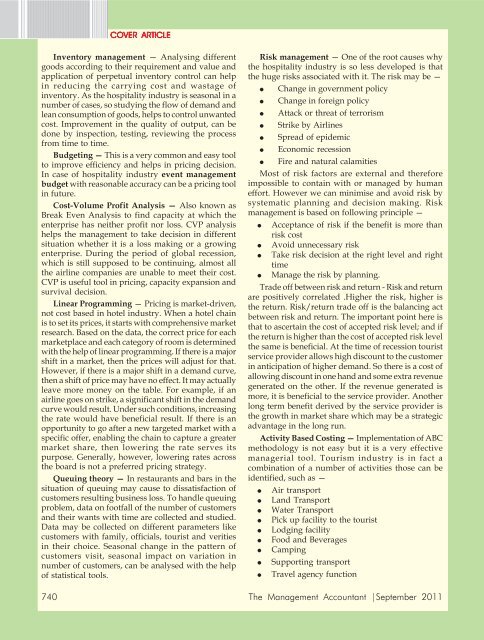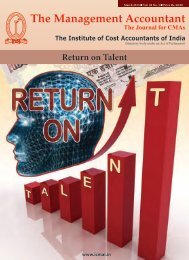This Issue - Icwai
This Issue - Icwai
This Issue - Icwai
Create successful ePaper yourself
Turn your PDF publications into a flip-book with our unique Google optimized e-Paper software.
COVER COVER ARTICLE<br />
ARTICLE<br />
Inventory management — Analysing different<br />
goods according to their requirement and value and<br />
application of perpetual inventory control can help<br />
in reducing the carrying cost and wastage of<br />
inventory. As the hospitality industry is seasonal in a<br />
number of cases, so studying the flow of demand and<br />
lean consumption of goods, helps to control unwanted<br />
cost. Improvement in the quality of output, can be<br />
done by inspection, testing, reviewing the process<br />
from time to time.<br />
Budgeting — <strong>This</strong> is a very common and easy tool<br />
to improve efficiency and helps in pricing decision.<br />
In case of hospitality industry event management<br />
budget with reasonable accuracy can be a pricing tool<br />
in future.<br />
Cost-Volume Profit Analysis — Also known as<br />
Break Even Analysis to find capacity at which the<br />
enterprise has neither profit nor loss. CVP analysis<br />
helps the management to take decision in different<br />
situation whether it is a loss making or a growing<br />
enterprise. During the period of global recession,<br />
which is still supposed to be continuing, almost all<br />
the airline companies are unable to meet their cost.<br />
CVP is useful tool in pricing, capacity expansion and<br />
survival decision.<br />
Linear Programming — Pricing is market-driven,<br />
not cost based in hotel industry. When a hotel chain<br />
is to set its prices, it starts with comprehensive market<br />
research. Based on the data, the correct price for each<br />
marketplace and each category of room is determined<br />
with the help of linear programming. If there is a major<br />
shift in a market, then the prices will adjust for that.<br />
However, if there is a major shift in a demand curve,<br />
then a shift of price may have no effect. It may actually<br />
leave more money on the table. For example, if an<br />
airline goes on strike, a significant shift in the demand<br />
curve would result. Under such conditions, increasing<br />
the rate would have beneficial result. If there is an<br />
opportunity to go after a new targeted market with a<br />
specific offer, enabling the chain to capture a greater<br />
market share, then lowering the rate serves its<br />
purpose. Generally, however, lowering rates across<br />
the board is not a preferred pricing strategy.<br />
Queuing theory — In restaurants and bars in the<br />
situation of queuing may cause to dissatisfaction of<br />
customers resulting business loss. To handle queuing<br />
problem, data on footfall of the number of customers<br />
and their wants with time are collected and studied.<br />
Data may be collected on different parameters like<br />
customers with family, officials, tourist and verities<br />
in their choice. Seasonal change in the pattern of<br />
customers visit, seasonal impact on variation in<br />
number of customers, can be analysed with the help<br />
of statistical tools.<br />
Risk management — One of the root causes why<br />
the hospitality industry is so less developed is that<br />
the huge risks associated with it. The risk may be —<br />
● Change in government policy<br />
● Change in foreign policy<br />
● Attack or threat of terrorism<br />
● Strike by Airlines<br />
● Spread of epidemic<br />
● Economic recession<br />
● Fire and natural calamities<br />
Most of risk factors are external and therefore<br />
impossible to contain with or managed by human<br />
effort. However we can minimise and avoid risk by<br />
systematic planning and decision making. Risk<br />
management is based on following principle —<br />
● Acceptance of risk if the benefit is more than<br />
risk cost<br />
● Avoid unnecessary risk<br />
● Take risk decision at the right level and right<br />
time<br />
● Manage the risk by planning.<br />
Trade off between risk and return - Risk and return<br />
are positively correlated .Higher the risk, higher is<br />
the return. Risk/return trade off is the balancing act<br />
between risk and return. The important point here is<br />
that to ascertain the cost of accepted risk level; and if<br />
the return is higher than the cost of accepted risk level<br />
the same is beneficial. At the time of recession tourist<br />
service provider allows high discount to the customer<br />
in anticipation of higher demand. So there is a cost of<br />
allowing discount in one hand and some extra revenue<br />
generated on the other. If the revenue generated is<br />
more, it is beneficial to the service provider. Another<br />
long term benefit derived by the service provider is<br />
the growth in market share which may be a strategic<br />
advantage in the long run.<br />
Activity Based Costing — Implementation of ABC<br />
methodology is not easy but it is a very effective<br />
managerial tool. Tourism industry is in fact a<br />
combination of a number of activities those can be<br />
identified, such as —<br />
● Air transport<br />
● Land Transport<br />
● Water Transport<br />
● Pick up facility to the tourist<br />
● Lodging facility<br />
● Food and Beverages<br />
● Camping<br />
● Supporting transport<br />
● Travel agency function<br />
740 The Management Accountant |September 2011




